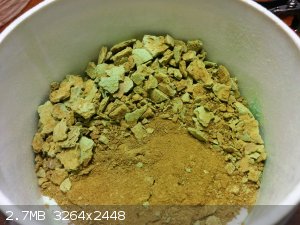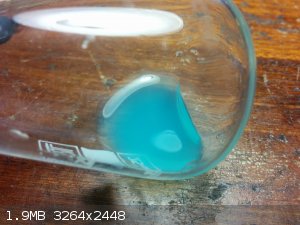| Pages:
1
2 |
Romix
Hazard to Others (Literally)
  
Posts: 427
Registered: 19-6-2015
Member Is Offline
Mood: No Mood
|
|
Quote: Originally posted by crystal grower  | Quote: Originally posted by MrHomeScientist  | | Sounds a lot like copper chloride to me. Anhydrous is brown, hydrated chloride is green, hydroxide is blue. The grey oxide doesn't fit, since it
should be black, but maybe there was incomplete decomposition. How hot did you heat it, and for how long? |
copper chloride is what came to my mind first (I've noticed this thread today as you posted this reply  ). ).
Try dissolving carbonate or hydroxide in sulfuric acid to see what colour does the sulfate is. |
No, there ain't a tenth of a procent of Cu+2 there.
You can clearly see Ni by the colour of complex.
And hydroxide of copper is dark blue! You are wrong.
[Edited on 15-9-2016 by Romix]
|
|
|
MrHomeScientist
International Hazard
    
Posts: 1806
Registered: 24-10-2010
Location: Flerovium
Member Is Offline
Mood: No Mood
|
|
If you're so confident it's nickel, why ask at all?
Have you done any actual tests for ions, or were you too busy dismissing our ideas out of hand?
|
|
|
Metallus
Hazard to Others
  
Posts: 116
Registered: 16-5-2013
Member Is Offline
Mood: No Mood
|
|
Try adding potassium iodide or sodium bisulfite in acidic solution or sodium bisulfite. Most transition metal ions in higher oxidation states are
mild/strong oxidants, so a reaction may occur.
Also, when I first looked at the pic you posted, I immediatly thought of copper chloride as well.
It's true, addition of ammonia will lead to the formation of a dark blue complex.... that is if you pour a lot of ammonia. If you added just a few
drops, the hydroxide will precipitate out just because of the pH increase.
Try drowning that salt in ammonia and tell us the results.
|
|
|
crystal grower
Hazard to Others
  
Posts: 474
Registered: 3-1-2016
Location: Os Petrosum
Member Is Offline
Mood: Puzzled
|
|
Simply precipitate carbonate, dissolve in sulfuric acid and let the sulfate crystallize. From the appearance of the crystals one can easily tell what
metal ion is present.
|
|
|
xfusion44
Hazard to Others
  
Posts: 223
Registered: 6-8-2014
Location: Europe
Member Is Offline
Mood: Nostalgic
|
|
This is copper chloride, for comparison:
Anhydrous (green pieces are a bit moist)

Solution with low concentration of chloride ions (higher concentration makes solution more greenish)

|
|
|
Romix
Hazard to Others (Literally)
  
Posts: 427
Registered: 19-6-2015
Member Is Offline
Mood: No Mood
|
|
Quote: Originally posted by Metallus  | Try adding potassium iodide or sodium bisulfite in acidic solution or sodium bisulfite. Most transition metal ions in higher oxidation states are
mild/strong oxidants, so a reaction may occur.
Also, when I first looked at the pic you posted, I immediatly thought of copper chloride as well.
It's true, addition of ammonia will lead to the formation of a dark blue complex.... that is if you pour a lot of ammonia. If you added just a few
drops, the hydroxide will precipitate out just because of the pH increase.
Try drowning that salt in ammonia and tell us the results. |
Ok, would oxide, hydroxide, carbonate of nickel dissolve in ammonia solution? Or precipitated mixture better to be dissolved in acid, before addition
of (aq) NH4OH. Metallic Ni reacts very very slow, compare to copper.
[Edited on 25-9-2016 by Romix]
|
|
|
Metallus
Hazard to Others
  
Posts: 116
Registered: 16-5-2013
Member Is Offline
Mood: No Mood
|
|
Quote: Originally posted by Romix  | Quote: Originally posted by Metallus  | Try adding potassium iodide or sodium bisulfite in acidic solution or sodium bisulfite. Most transition metal ions in higher oxidation states are
mild/strong oxidants, so a reaction may occur.
Also, when I first looked at the pic you posted, I immediatly thought of copper chloride as well.
It's true, addition of ammonia will lead to the formation of a dark blue complex.... that is if you pour a lot of ammonia. If you added just a few
drops, the hydroxide will precipitate out just because of the pH increase.
Try drowning that salt in ammonia and tell us the results. |
Ok, would oxide, hydroxide, carbonate of nickel dissolve in ammonia solution? Or precipitated mixture better to be dissolved in acid, before addition
of (aq) NH4OH. Metallic Ni reacts very very slow, compare to copper.
[Edited on 25-9-2016 by Romix] |
Yes, when you drown your precipitated oxide/hydroxide in ammonia, a good part should re-dissolve. I never tried dissolving a carbonate with ammonia,
so you may try to first bubble out all the CO2 in acid solution, then neutralize and add ammonia.
This was part of a lab experience my professor made me do: precipitation of copper/zinc hydroxide with a few drops of ammonia, and then re-dissolution
when a lot of ammonia is added.
Co, Ni, Cu, Zn behave like that and they all give different colors (magenta, violet, deep blue and colorless respectively).
[Edited on 27-9-2016 by Metallus]
|
|
|
Camroc37
Hazard to Others
  
Posts: 101
Registered: 4-8-2015
Location: USA
Member Is Offline
Mood: Must...Nitrate...EVERYTHING!
|
|
Quote: Originally posted by Romix  | At the start it's purple, then colorless.
Valency change?
Then turning green, possibly nickel starting oxidizing, or reacting with solution.
Carbonate and hydroxide. same colour.
[Edited on 17-4-2016 by Romix] |
Possibly Vanadium? Not sure though
|
|
|
Metallus
Hazard to Others
  
Posts: 116
Registered: 16-5-2013
Member Is Offline
Mood: No Mood
|
|
This may come into hand when you need to differentiate colors in different mediums.
http://www.docbrown.info/page07/SSquestions/transppt.gif
If it's vanadium, then it should give some signs of reaction with reductants (in which case, try acid solution of bisulfite; it should turn from
yellow/orange -> light blue)
|
|
|
AJKOER
Radically Dubious
    
Posts: 3026
Registered: 7-5-2011
Member Is Offline
Mood: No Mood
|
|
What is the source of the salt?
If a school project, not likely an expense salt.
From electronic equipment,...., which may give clues.
Try a flame test.
Heat it to glowing or nearly so and drop it into a bottle of hydrogen. Carefully smell ( you may wish to check first with the teacher if this would be
a reasonably safe procedure for the sample of salts distributed to the class) the gas and examine any metal liberated, including its color, density,
melting point, reactivity to water, dilute and strong acid.
[Edited on 18-10-2016 by AJKOER]
|
|
|
| Pages:
1
2 |